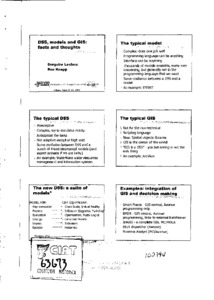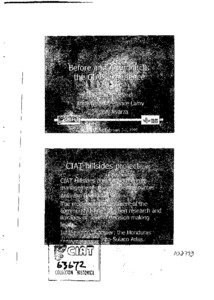Guía para la cartografía de niveles de restricción de los suelos, utilizando el sistema de información geográfica "MAP Maker Popular" y la hoja electrónica Excel
Mapeo, análisis y monitoreo participativos de los recursos naturales en una microcuenca
Modeling water resources management at the basin level: review and future directions
The world is facing severe and growing challenges in maintaining water quality and meeting the rapidly growing demand for water resources. In addition, water used for irrigation, the largest use of water in most developing countries, will likely have to be diverted increasingly to meet the needs of urban areas and industry whilst remaining a prime engine of agricultural growth. Finally, environmental and other in-stream water demands become more important as economies develop.
Performance evaluation of the Bhakra Irrigation System, India, using remote sensing and GIS techniques
Describes the use of satellite remote sensing and GIs techniques to analyze the agricultural performance and sustainability of the Bhakra Irrigation System in India. Demonstrates the cost-effectiveness of these techniques as diagnostic tools for irrigation system improvement and the advantages of using SRS and GIs in combination.
Remote sensing and hydrologic models for performance assessment in Sirsa Irrigation Circle, India
Describes the results of an irrigation performance evaluation using remote sensing techniques, GIS procedures, and hydrologic modeling at a regional scale. Demonstrates how advanced information technologies support the analysis of irrigation performance by facilitating an in-depth study of a large irrigated area.
Tools for disaster mitigation workshop : Before and after Mitch: The CIAT experience
Use of GIS in land resources management in the Colombian Orinoco Region
Using GIS techniques to aid in predicting a plant virus in beans
Geographical information systems (GIS) assist us in mapping and analyzing outbreaks of diseases in plants, animals and humans. This paper describes how GIS are being used to model the intensity of the outbreak of a plant virus, bean golden mosaic virus (BGMV) in Guatemala, Honduras and El Salvador. BGMV is a geminivirus affecting beans (Phaseolus vulgaris) and is transmitted by a vector, the sweet potato whitefly (Bemisia tabaci). Once a plant is infected by the virus yield losses, at varying locations, can range from 40% to 100%.
Het eenduidig bodemgebruiksbestand; Methode en validatie voor 1997
Agents als concept voor het modelleren van de ruimte
De afzonderlijke en gecombineerde werking van 2 technieken, Cellulaire Automata en Multi Agent Simulatie, voor het modelleren van ruimtelijke processen worden besproken






